Photo Shoot: A Journey in the Evolution of Fashion - 1920s to 1950s
March 22, 2013 2“Fashion must be placed firmly within its cultural and historical context; the study of dress cannot be separated from women’s history,” Valerie Steele, Fifty Years of Fashion.
Fashion is one of the richest angles of which one can study history and politics of every decade. What some may think of as mere outfits, can tell a lot about the people’s mindset, culture and practiced traditions.
The 1900s are full of rich design staples that not only set the trend for decades to come, but also tell a lot about world history.
In part one of this feature, we take you through the fashion evolution from the 1920s through to the 1950s, reflecting the overall mood of each decade through its different fashion trends.
This feature would not have come together if it weren’t for the efforts of some of the most talented and passionate artists we have worked with; photographer Hatem Saleh, stylist Sundos Al Ayoub, makeup artist Noha Ghoname and hair stylist Rafi from Mohamed Sagheer group. (Look out for a special feature introducing each one of them as they offer you exclusive tips on how to be your own fashion, hair and makeup stylists).
Also, this shoot wouldn’t have been possible if it wasn’t for the stores and oh-so-many friends’, mothers’, stylists’ and fashionistas’ closets we raided for actual vintage pieces from these decades or new ones that our resourceful stylist put her vintage twist on.
The Roaring 20s
“Fashion has become a joke. The designers have forgotten that there are women inside the dresses. Most women dress for men and want to be admired. But they must also be able to move, to get into a car without bursting their seams,” Coco Chanel.
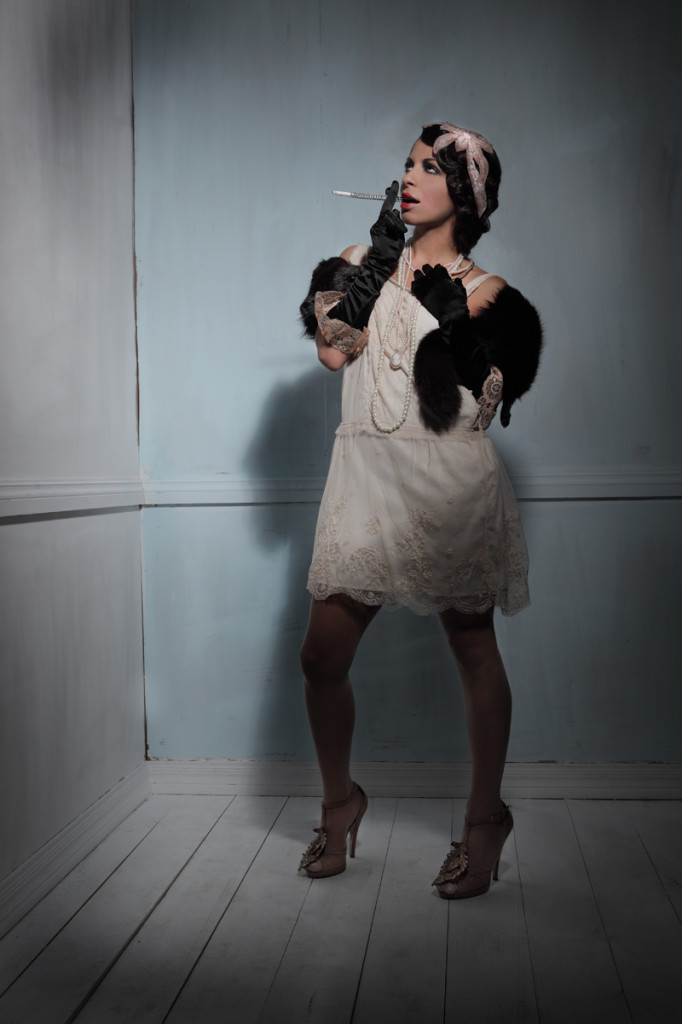
Photography: Hatem Saleh | Model: Iman ElSherbiny | Hair by Rafi, Mohamed Sagheer Group | Makeup: Noha Ghoname | Headpiece: designed by Sundos El Ayoub | Diamanté cigarette holder: designed by Sundos El Ayoub | Elbow satin gloves: Altered by Sundos El Ayoub | Vintage genuine fox wrap: owned by Shadya El Halawany | Necklaces: Nomrosy | Lace dress: Hoss Intropia from Rania’s Corner | Ankle wrap sandals: Nadine El Sayed’s and altered by Sundos El Ayoub
After years of women choking in what seemed to be torture costumes, what with the tight bodices and suffocating waistlines, Coco Chanel introduced designs that allowed women to get the freedom they’ve been hungry for. She “let go of the waistline” and introduced the beauty of comfortable designs.
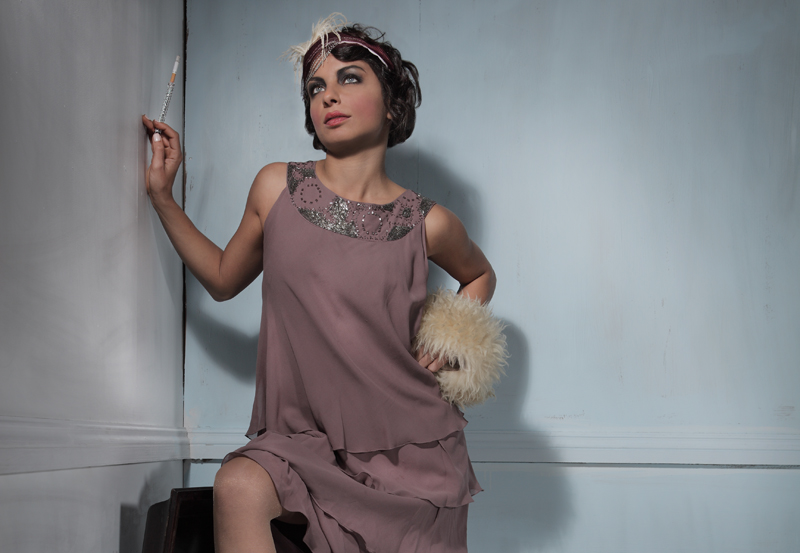
Photography: Hatem Saleh | Model: Iman ElSherbiny | Hair by Rafi, Mohamed Sagheer Group | Makeup: Noha Ghoname | Headband: designed by Sundos El Ayoub | Dress: Heba Hassabo’s | Vintage fur hand warmer: owned by Faika Abdel Malek | Cigarette Holder: design by Sundos El Ayoub | shoes: owned by Nadine El Sayed’s
The 20s saw drastic and extreme changes accompanied by an equally extreme attitude turning women into rebellious, excessive drinkers (an act that was prohibited in the US at the time) and smokers with ‘reckless’ sexual behavior, what was then referred to as the ‘flapper attitude.’ It was all about heavy makeup, short hair, jazz parties and breaking free from any restrictions.
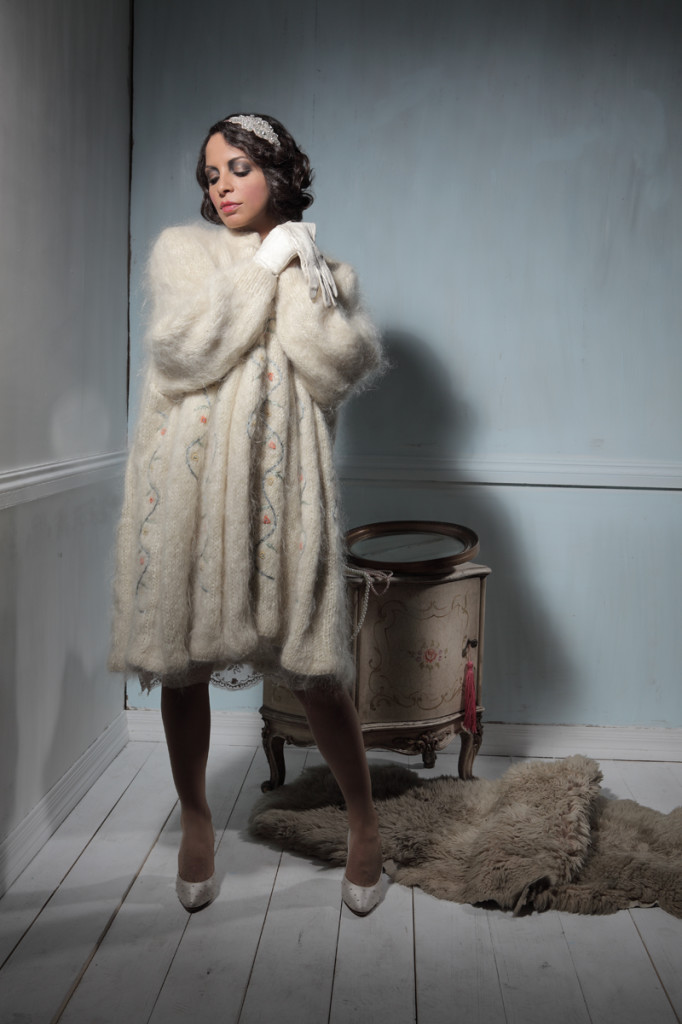
Photography: Hatem Saleh | Model: Iman ElSherbiny | Hair by Rafi, Mohamed Sagheer Group | Makeup: Noha Ghoname | Headband: Nadine El Sayed | Vintage Circa coat: owned by Salwa Eldidi | Gloves: Flea Market | Vintage shoes: owned by Faika Abdel Malek
The changes in fashion trends reflected the political and cultural situation at the time that gave women more freedom and social status. Women were liberated from corsets, giving way for a new boyish look, they began to gain equality with men and cut their hair short to reflect that.
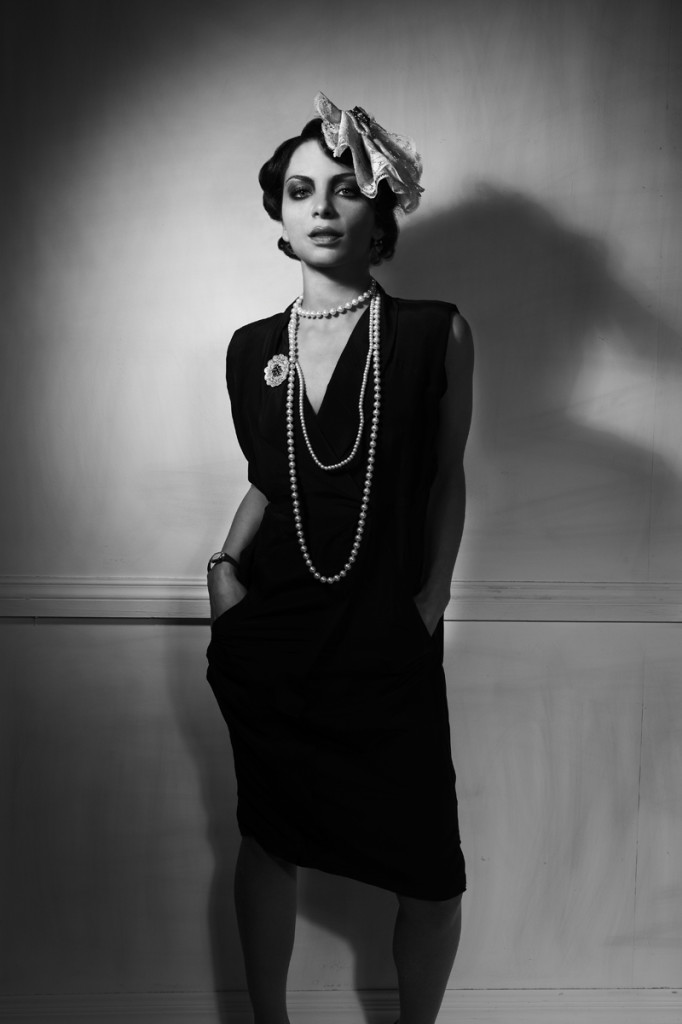
Photography: Hatem Saleh | Model: Iman ElSherbiny | Hair by Rafi, Mohamed Sagheer Group | Makeup: Noha Ghoname | Headpiece: Stylist design | Necklaces: Nomrosy | Black dress: Jan Ahlgren from Rania’s Corner | Vintage Brooch: owned by Sundos El Ayoub | Vintage watch: owned by Salwa Eldidi
“One is never over nor under dressed in a little black dress,” Coco Chanel.
October 1st, 1926 was the day Vogue ran a feature with an illustrated image of the black dress introduced by Coco Chanel, a dress they then compared to the staple Ford of the era calling it “Chanel’s Ford.” The Little Black Dress (LBD), Vogue said, would be “a sort of uniform for all women of taste.”
The romantic and feminine 30s
The first chunk of the 30s was still mainly influenced by the 20s flapper attitude; it wasn’t until the later years that the Great Depression had its effect on fashion. Women started wearing longer skirts taking the waistline back to its original place with a dramatic drop in hemlines in hopes to bring back the more ‘womanly’ attitude and look.
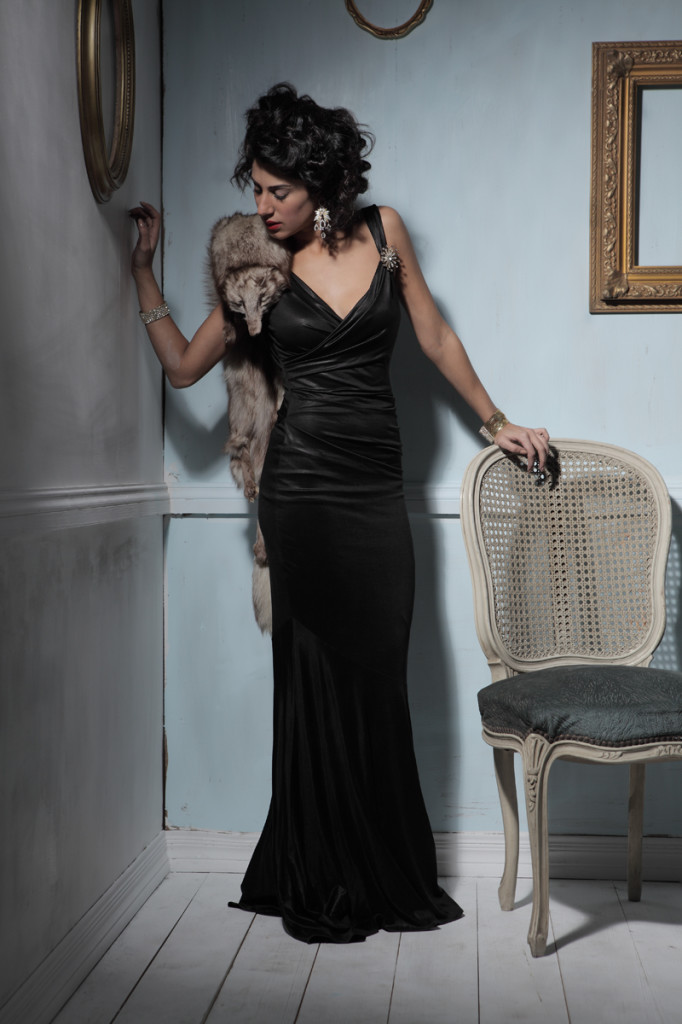
Photography: Hatem Saleh | Model: Sundos Al Ayoub | Hair by Rafi, Mohamed Sagheer Group | Makeup: Noha Ghoname | Diamond earrings: owned by Salwa Eldidi | Vintage genuine fox wrap: owned by Shadya El Halawany | Black dress: owned by Sundos El Ayoub | Vintage brooch: owned by Sundos El Ayoub | Bracelets: owned by Sundos El Ayoub
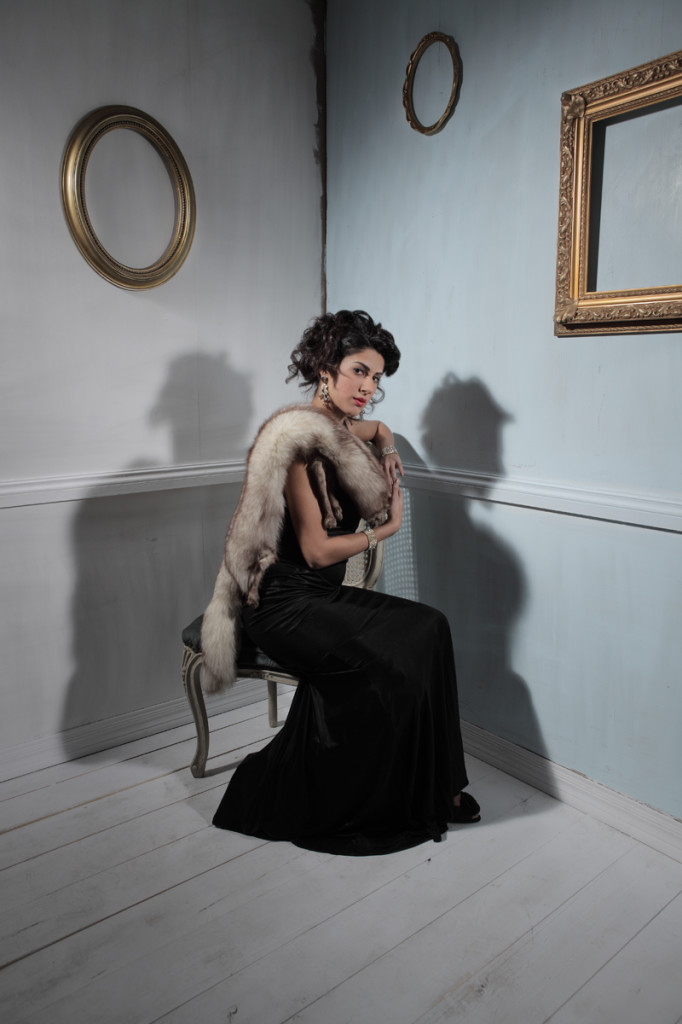
Photography: Hatem Saleh | Model: Sundos Al Ayoub | Hair by Rafi, Mohamed Sagheer Group | Makeup: Noha Ghoname | Diamond earrings: owned by Salwa Eldidi | Vintage genuine fox wrap: owned by Shadya El Halawany | Black dress: owned by Sundos El Ayoub | Vintage brooch: owned by Sundos El Ayoub | Bracelets: owned by Sundos El Ayoub
“When a woman smiles, then her dress should smile too,” said Madeleine Vionnet, dubbed the “Queen of the bias cut” and “architect among dressmakers.”
The 1930s were all about a woman’s curves, which were most reflected through the ‘bias cut’ introduced by Vionnet. She designed dresses in a way that defined a woman’s contours, decorating her shape using mostly silk, chiffon, Moroccan crepe and other fabrics that would sensually drape the body.
Fur was also excessively worn, day and night.
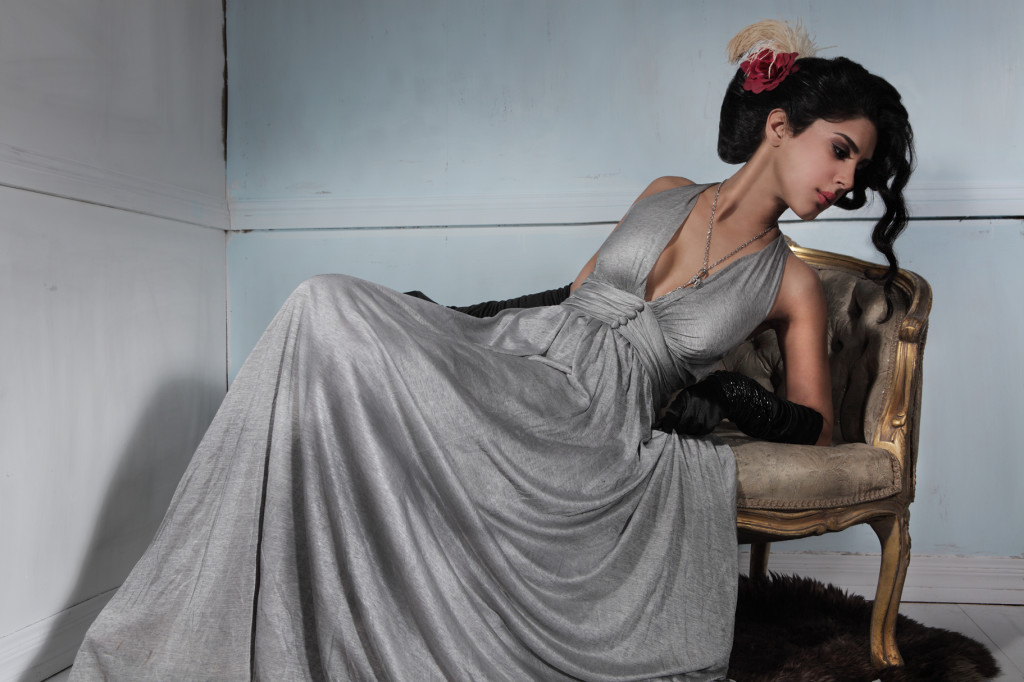
Photography: Hatem Saleh | Model: Sundos El Ayoub | Hair by Rafi, Mohamed Sagheer Group | Makeup: Noha Ghoname | Hair accessories: designed by Sundos El Ayoub | Necklace: owned by Sundos El Ayoub | Grey dress: Aseela Rentals | Gloves: Nomrossy
Fashion in the 30s was more influenced by Hollywood’s glamour where a woman’s form was accentuated through long classy dresses that made the bodies seem longer and leaner. Backs were mostly exposed along with V-neck cuts and beautifully bare shoulders while the knees were always covered.
Photography: Hatem Saleh | Model: Sundos Al Ayoub | Hair by Rafi, Mohamed Sagheer Group | Makeup: Noha Ghoname | Hat: Aseela Rentals, altered by Sundos El Ayoub | Pearl earrings: owned by Sundos El Ayoub | Silk ruffle shirt: Hoss Intropia from Rania’s Corner | Jacket: owned by Sundos El Ayoub | Belt: Sally Lapointe from Rania’s Corner | Lace layered skirt: Aseela Rentals | Shoes: owned by Sundos El Ayoub | Vintage bag: owned by Salwa Eldidi
During day time, and for less glamorous night out, the fitted bodices made a comeback, but without their exaggerated suffocating feel, and were mostly decorated with ruffles and complimented with equally full or ruffled skirts.
Hats were worn with a tilt calling for even more attention to the feminine form and style.
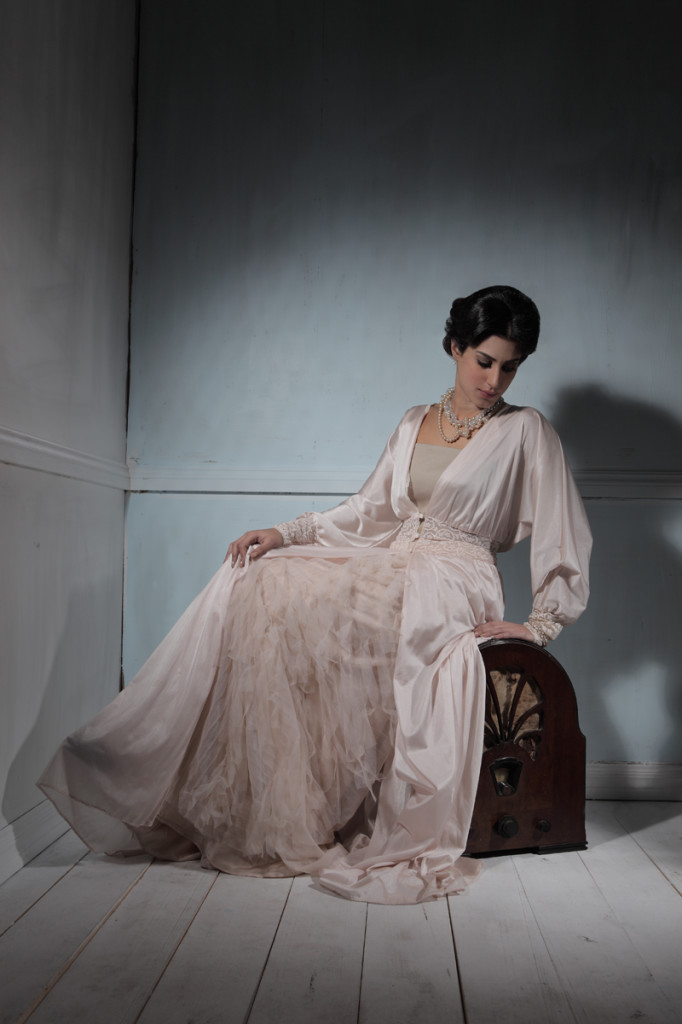
Photography: Hatem Saleh | Model: Sundos Al Ayoub | Hair by Rafi, Mohamed Sagheer Group | Makeup: Noha Ghoname | Necklace: owned by Sundos El Ayoub | Silk robe: owned by Salwa Eldidi | Dress: Sachin & Babi from Rania’s Corner
Women in the 30s didn’t show skin like they did in the 20s; they simply wore their glamorous silk draped gowns and managed to look even sexier.
Silk added to the sensual feel of every dress and was widely used in the 30s before it was time for second world war in the 40s where silk would be banned and used instead for making soldiers’ parachutes.
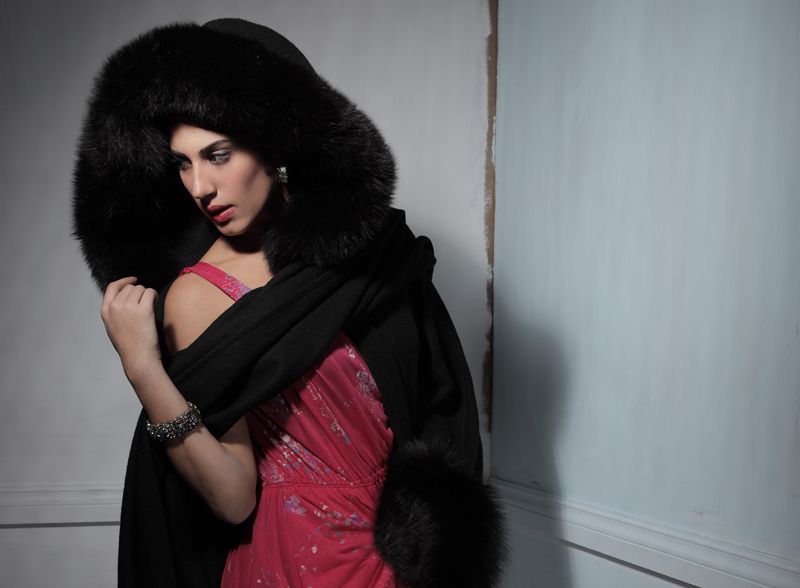
Photography: Hatem Saleh | Model: Sundos Al Ayoub | Hair by Rafi, Mohamed Sagheer Group | Makeup: Noha Ghoname | Trimmed coat: owned by Sundos El Ayoub | Vintage pink chiffon dress: owned by Faika Abdel Malek
The 30s saw the first appearance of Elsa Schiaparelli’s “shocking pink” which she said was “life-giving, like all the light and the birds and the fish in the world put together, a color of China and Peru but not of the West.”
The 40s, fashion at times of war
It was wartime and a lot of fabrics were not as accessible but rather used to make parachutes and uniforms for soldiers; women had to worry about practicality and functionality of their outfits as they ran around for errands and went to church. Money was not in abundance either so women were always encouraged to knit and sew their own clothes with whatever available fabric at the time.
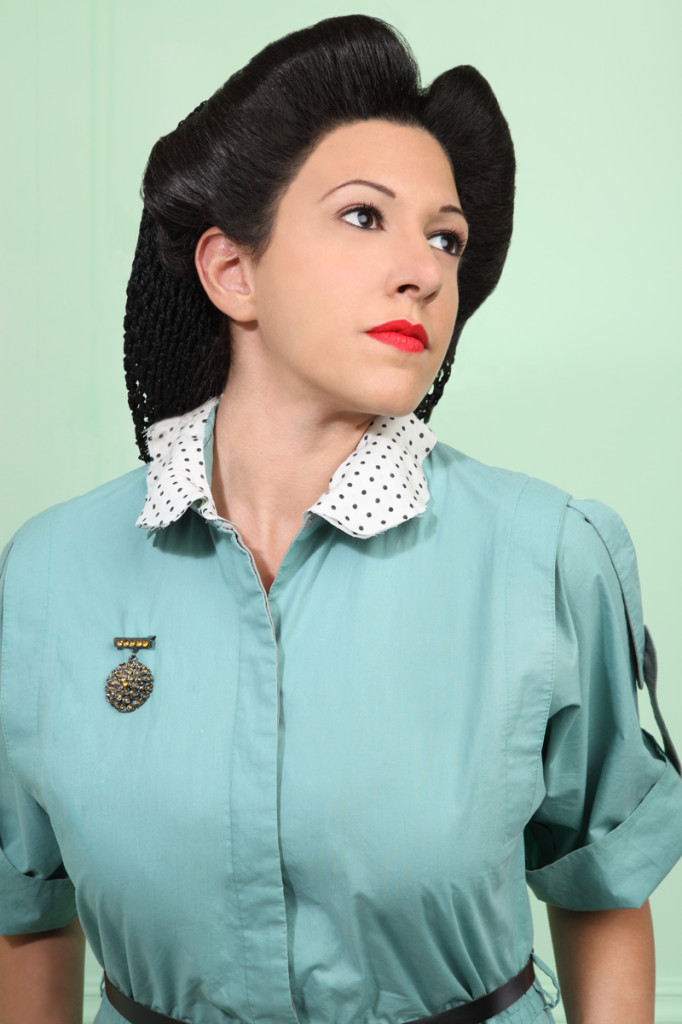
Photography: Hatem Saleh | Model: Noha Nabil | Hair by Rafi, Mohamed Sagheer Group | Makeup: Noha Ghoname | Shirt dress: Aly Aly, altered by Sundos El Ayoub | Vintage Brooch: owned by Sundos El Ayoub
Day dresses were more of shirtdresses for practical reasons, making a come back later on in the 80s.
Hair and makeup were given more attention so women would feel some sort of contrast whilst they wore their dull outfits. Hair was rolled up and secured with bobby pins while makeup was worn dramatically, using matte foundation and bright red lipstick. In a way, the excessive make up was used to disguise sorrow and reflect power.
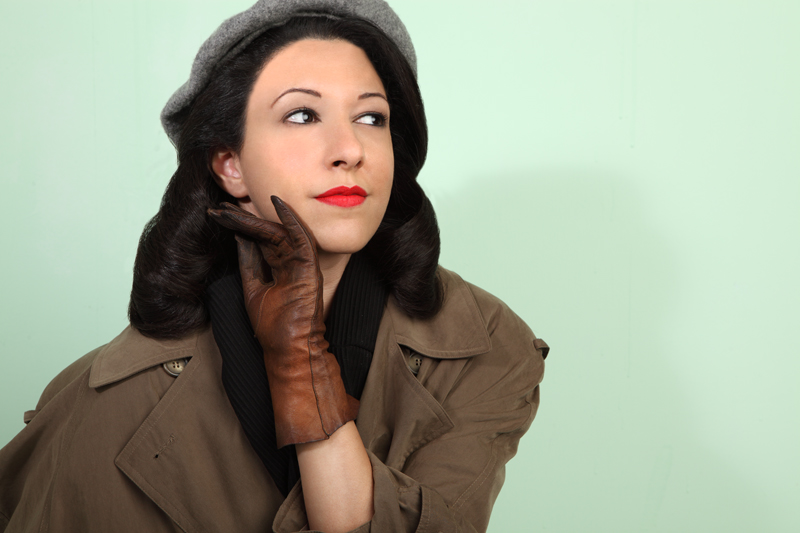
Photography: Hatem Saleh | Model: Noha Nabil | Hair by Rafi, Mohamed Sagheer Group | Makeup: Noha Ghoname | Grey beret: owned by Sundos El Ayoub | Leather gloves: Flea market | Vintage Burberry Trench coat: owned by Faika Abdel Malek
Designers barely designed anything between the years of 1939 and 1945 and that’s when women were left with no choice but to improvise and make the best out of the limited resources they had available. A trench coat was a classic piece widely worn at the time. Because of new trends being in limbo due to war, women had to sometimes resort to their absent men’s closets styling their oversized coats as their own; that is how structured shouldered coats came into fashion.
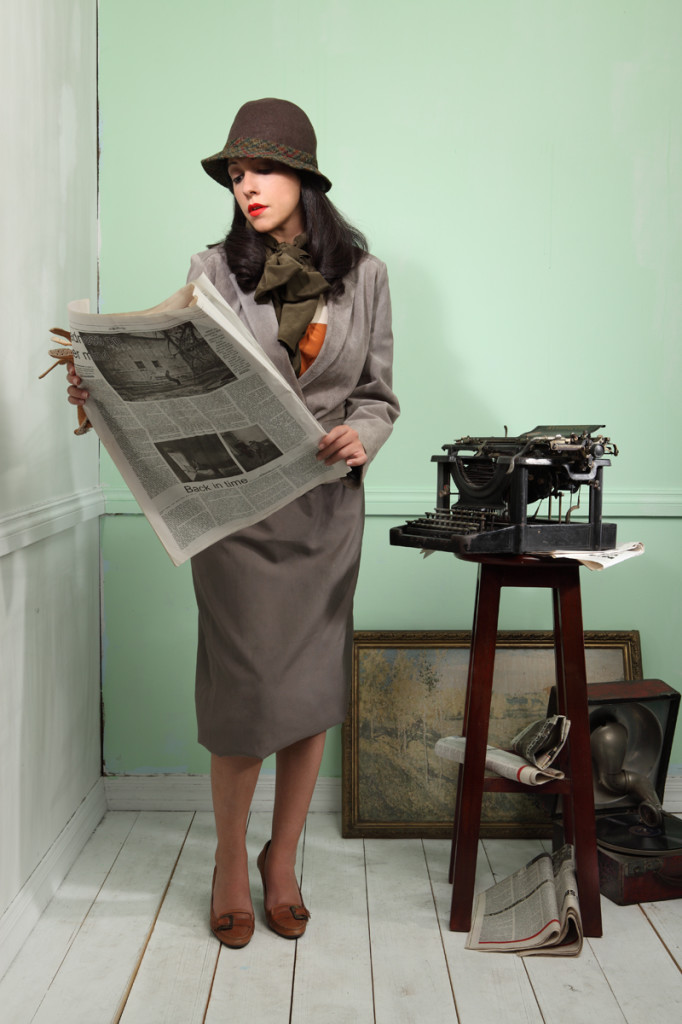
Photography: Hatem Saleh | Model: Noha Nabil | Hair by Rafi, Mohamed Sagheer Group | Makeup: Noha Ghoname | Hat: HTC from Rania’s Corner | Silk Shirt: owned by Faika Abdel Malek | Vintage Suede jacket: owned by Faika Abdel Malek | Vintage grey skirt: owned by Faika Abdel Malek | Shoes: Nadine El Sayed’s
Dresses and skirts were loose and with more of an A-Lined fit covering to just below the kneecap for practicality when walking around, hemlines were straight and neat; otherwise the woman would look shamelessly sloppy. Colors were always subdued to reflect the wartime mood.
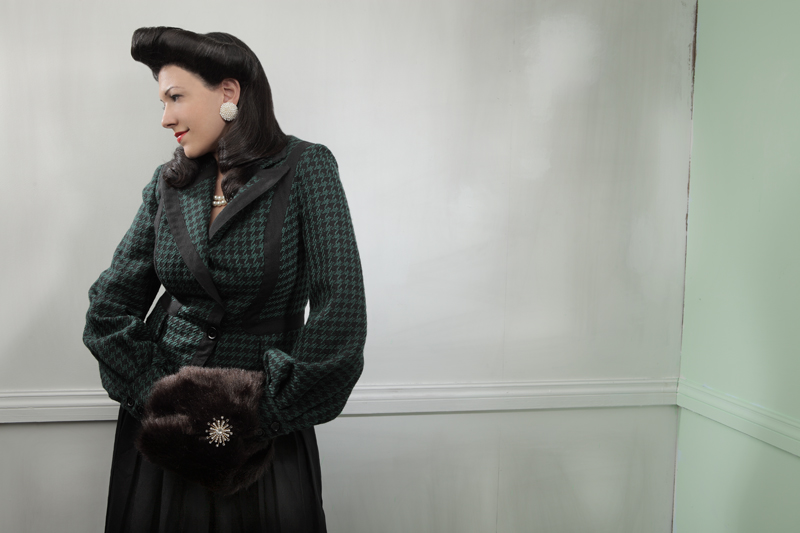
Photography: Hatem Saleh | Model: Noha Nabil | Hair by Rafi, Mohamed Sagheer Group | Makeup: Noha Ghoname | Earring and necklace: owned by Sundos El Ayoub | Jacket: Julien Macdonald from HIP | Fur hand warmer and brooch: designed by Sundos El Ayoub | Skirt: owned by Faika Abdel Malek
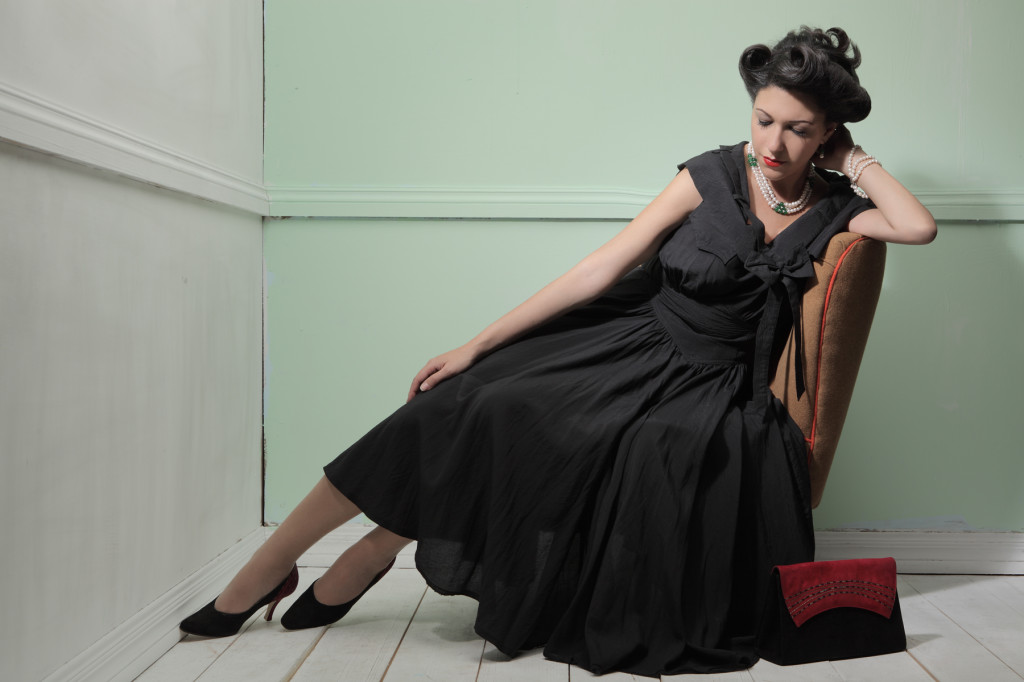
Photography: Hatem Saleh | Model: Noha Nabil | Hair by Rafi, Mohamed Sagheer Group | Makeup: Noha Ghoname | Necklace and bracelet: owned by Salwa Eldidi | Vintage dress: owned by Faika Abdel Malek | Shoes and bag: owned by Salwa Eldidi | Chair: Vermissen from Rania’s Corner
Soon after the war was over, and specifically in the late 40s, the soft look made a come back and designers went back to business with beautifully cut dresses and skirts making way for the 50s more stunningly feminine fashion.
1950s, Couture and Conformity
The early 50s revolutionized the military-look and wartime fashion of the 40s with Paris ruling the world of fashion. Women wanted their sophisticated outfits back, ones that accentuated their femininity and elegance.
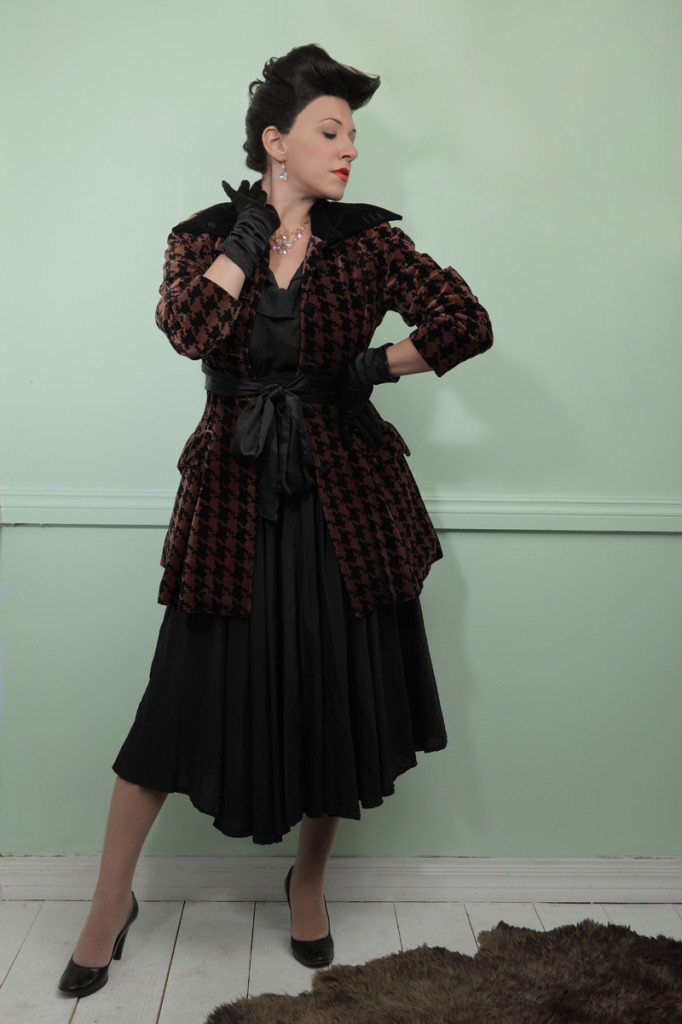
Photography: Hatem Saleh | Model: Noha Nabil | Hair by Rafi, Mohamed Sagheer Group | Makeup: Noha Ghoname | Accessories: owned by Sundos El Ayoub | Jacket: Salwa Eldidi | Skirt: owned by Faika Abdel Malek | Gloves: Nomrossy | Shoes: Hadeel El Deeb’s
Christian Dior was the iconic designer of the decade, with his fitted jacket and nipped waist dominating the early 50s and bringing the ‘wasp-stung waist’ back in style. His iconic cuts were dubbed ‘The New Look.’
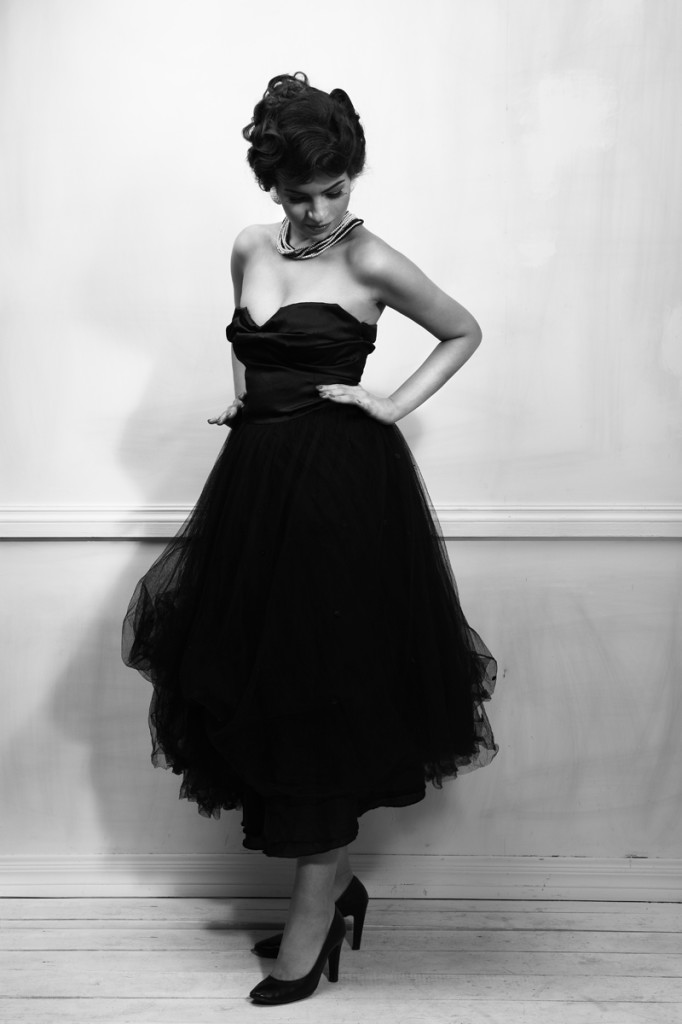
Photography: Hatem Saleh | Model: Aicha El Shabrawy | Hair by Rafi, Mohamed Sagheer Group | Makeup: Noha Ghoname | Accessories: owned by Sundos El Ayoub | Black dress: designed by Sundos El Ayoub | Shoes: Hadeel El Deeb’s
The use of excessive material in Dior’s designs was an obvious contrast to the US government’s restrictions during the previous war years, especially that such luxurious fabrics were sill hard to find even after the war was over. Dior, however, always managed to get abundant amounts to design his heavily padded and ruffled skirts.
“The New Look brought me heavy mail. Letters arrived by the thousands —mostly enthusiastic, but some indignant. A garage owner from Los Angeles wrote and told me that he had sworn to ‘tear me apart’ on his next visit to Paris. According to him, it was my fault that his wife looked like a stuffed doll of the time of the Civil War,” Dior was quoted saying.
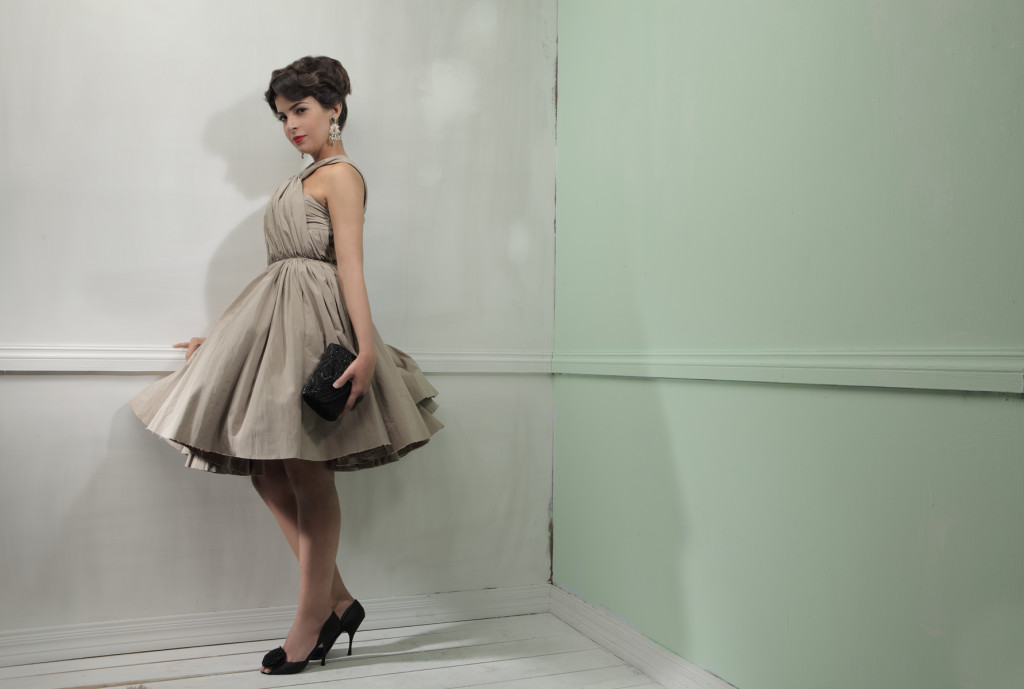
Photography: Hatem Saleh | Model: Aicha El Shabrawy | Hair by Rafi, Mohamed Sagheer Group | Makeup: Noha Ghoname | Diamond earrings: owned by Sundos El Ayoub | Dress: Lanvin from HIP | Clutch: owned by Sundos El Ayoub | Shoes: owned by Sundos El Ayoub
Dior announced that his aim was to “save women from nature” and make them all look beautiful.
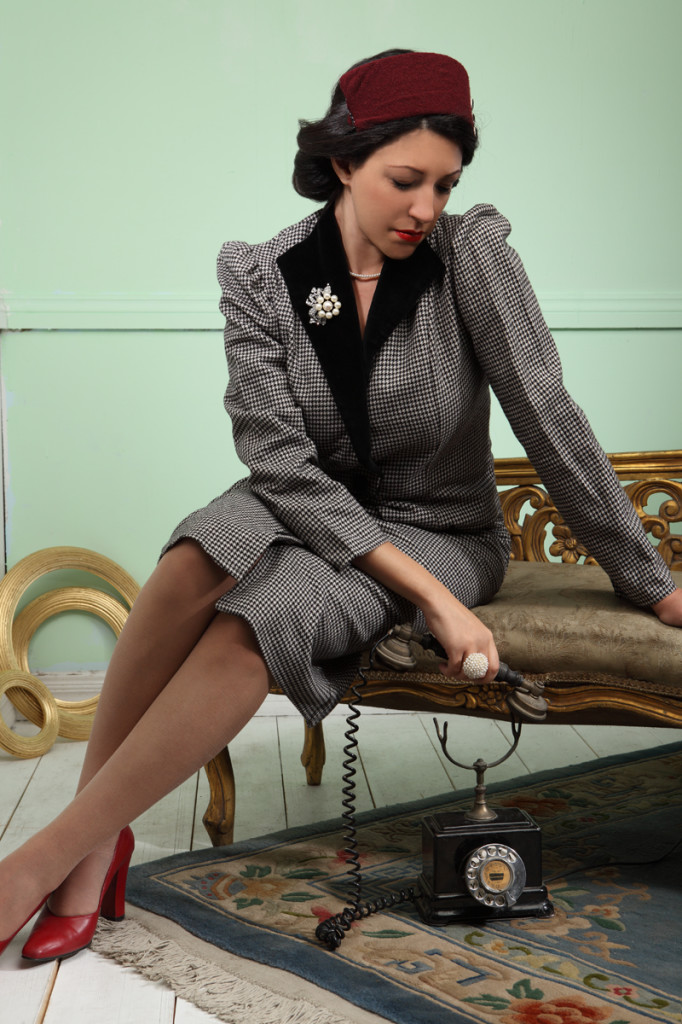
Photography: Hatem Saleh | Model: Noha Nabil | Hair by Rafi, Mohamed Sagheer Group | Makeup: Noha Ghoname | Headpiece: designed by Sundos El Ayoub | Vintage suit: owned by Faika Abdel Malek | Vintage brooch: owned by Salwa Eldidi | Pearl necklace and earring: owned by Sundos El Ayoub | Shoes: owned by Salwa Eldidi
Some designer rivalry was taking place in the mid 50s when French designer Jacques Fath said, “women are bad fashion designers. The only role a woman should have in fashion is wearing clothes. Some day all the great designers will be men.”
The statement offended women and female designers alike, including Coco Chanel, who commented saying, “Mr. Fath’s statement needs no answer. Facts will answer him.” A few months later she re-opened her couture house and “started proving to male designers that they put women in uncomfortable, impractical clothes,” Valerie Steele, Fifty Years of Fashion. The year 1954 marked the iconic ‘Chanel Suit,’ which was made of classic tweed, knee length skirt, and a boxy jacket.
“Men make clothes in which one can’t move,” Coco Chanel.
Check out part two of this feature taking you on a completely different feel of fashion, kicking off with the 60s’ Sack dresses and the ‘youthquake.’
-
Thank you for the images of the girls which I enjoyed. Yes it is retro but also retro in the sense that many arab women would never have had an oppotunity to live in the 1920’s as such. So this is a sort of retrospective owning of a period which was taboo
Calum
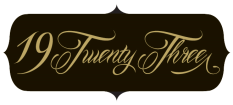
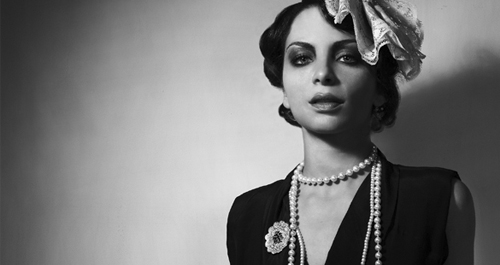
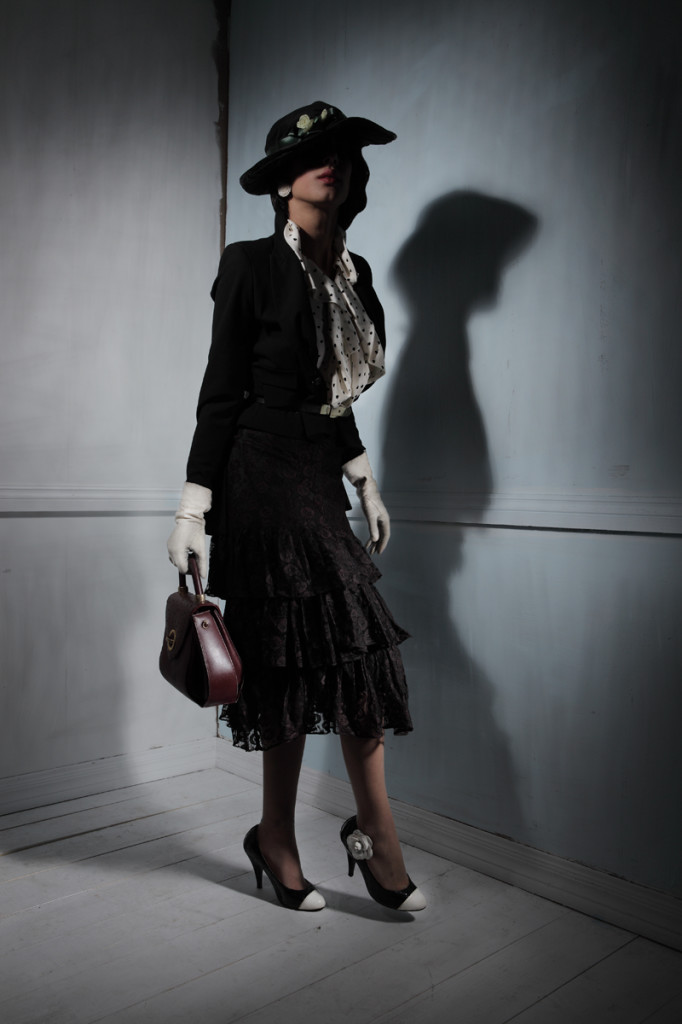
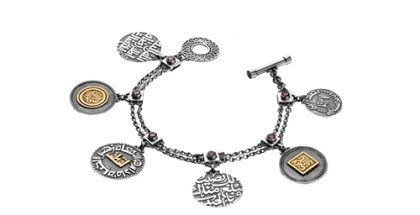
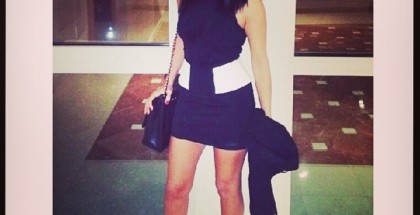
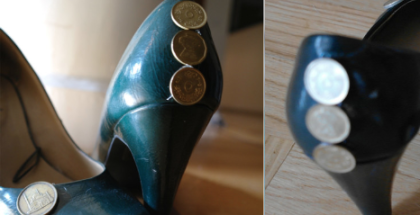
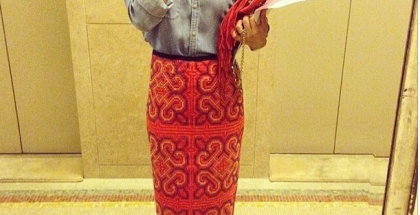
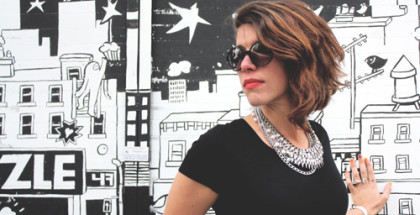
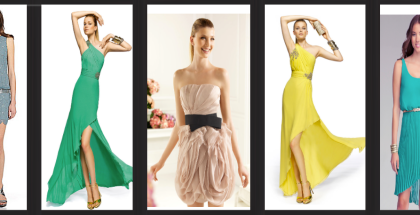
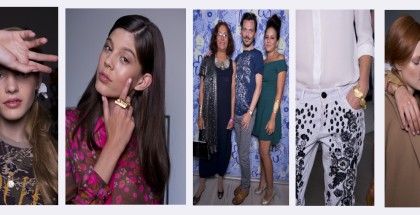
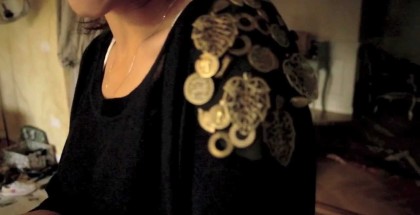
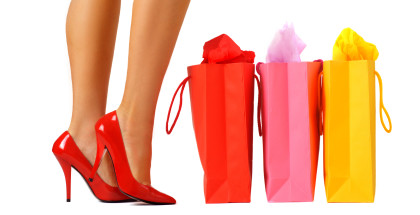
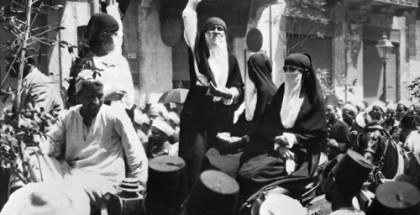
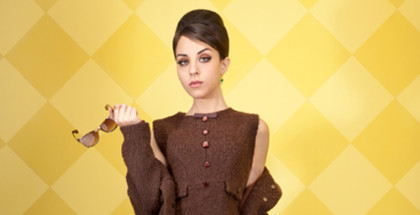
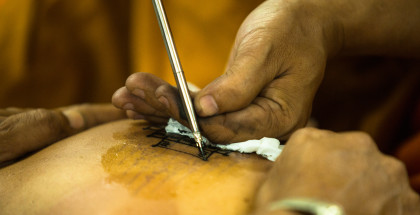













Comments